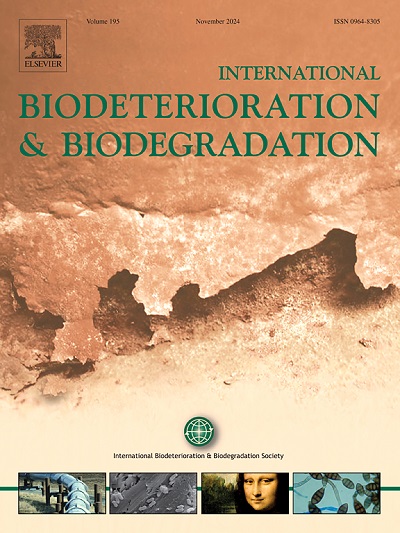Unveiling the catabolic biodegradation of pymetrozine in Pseudomonas guariconensis strain BYT-5 through genomics studies
IF 4.1
2区 环境科学与生态学
Q2 BIOTECHNOLOGY & APPLIED MICROBIOLOGY
International Biodeterioration & Biodegradation
Pub Date : 2025-02-01
DOI:10.1016/j.ibiod.2024.105991
引用次数: 0
Abstract
Pymetrozine boosts crop yields by managing insect pests, but the United States Environmental Protection Agency (USEPA) has labeled it a potential carcinogen for its detrimental effects on human reproduction and respiratory health. In this study, Pseudomonas guariconensis strain BYT-5, capable of degrading pymetrozine via a typical metabolic pathway as its sole carbon source for growth, was isolated. Genome sequencing and analysis of strain BYT-5 revealed the presence of the pymetrozine hydrolase gene pyzH and two nicotinic acid (NA) catabolic gene clusters, nic1 (nicAB1R1X1C1D1E1F1T1) and nic2 (nicR2X2C2D2E2F2T2B2). Verification of these genes was achieved through heterologous expression, gene knockout, and complementation assays. The gene pyzH initiated the breakdown of pymetrozine into 4-amino-6-methyl-4,5-dihydro-2H-[1,2,4]triazin-3-one (AMDT) and nicotinaldehyde, which was further oxidized to nicotinic acid (NA) by non-specific dehydrogenases. The genes nicAB1, nicC2, and nicX1 sequentially converted NA into 6-hydroxynicotinic acid (6HNA), 2,5-dihydroxypyridine (2,5-DHP), and N-formylmaleamic acid (NFM), respectively. The genes nicD2E2F2 was ultimately responsible for converting NFM to fumaric acid, entering the TCA cycle. Furthermore, the presence of diverse transposases around the pyzH, nic1, and nic2 clusters may facilitate BYT-5's acquisition of genes necessary for pymetrozine degradation. This study elucidates the molecular metabolic mechanism of pymetrozine at the molecular level.

通过基因组学研究揭示guariconpseudomonas BYT-5菌株pymetrozine的分解代谢生物降解
吡蚜酮通过控制害虫来提高作物产量,但美国环境保护署(USEPA)已将其列为潜在致癌物,因为它对人类生殖和呼吸系统健康有有害影响。本研究分离了guariconensis假单胞菌BYT-5,该菌株能够通过典型的代谢途径降解吡蚜酮,并作为其生长的唯一碳源。菌株BYT-5的基因组测序和分析显示,存在pyzH酶基因和nic1 (nicAB1R1X1C1D1E1F1T1)和nic2 (nicR2X2C2D2E2F2T2B2)两个烟酸(NA)分解代谢基因簇。这些基因的验证是通过异种表达、基因敲除和互补试验来实现的。pyzH基因启动pymemezine分解为4-氨基-6-甲基-4,5-二氢- 2h -[1,2,4]三嗪-3-one (AMDT)和烟醛,并被非特异性脱氢酶进一步氧化为烟酸(NA)。nicAB1、nicC2和nicX1基因依次将NA转化为6-羟基烟酸(6HNA)、2,5-二羟基吡啶(2,5- dhp)和n -甲酰基马来酸(NFM)。nicD2E2F2基因最终负责将NFM转化为富马酸,进入TCA循环。此外,pyzH、nic1和nic2簇周围不同转座的存在可能有助于BYT-5获得pymetrozine降解所需的基因。本研究在分子水平上阐明了吡蚜酮的分子代谢机制。
本文章由计算机程序翻译,如有差异,请以英文原文为准。
求助全文
约1分钟内获得全文
求助全文
来源期刊
CiteScore
9.60
自引率
10.40%
发文量
107
审稿时长
21 days
期刊介绍:
International Biodeterioration and Biodegradation publishes original research papers and reviews on the biological causes of deterioration or degradation.

 求助内容:
求助内容: 应助结果提醒方式:
应助结果提醒方式:


